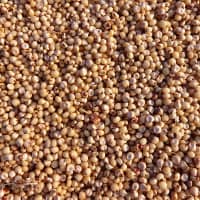Mustard is made from the seeds of the mustard plant. The mustard plant belongs to the angiosperm family, Brassicacea.[1]
There are three known edible species of mustard:
- White/yellow mustard, (Sinapis alba/ Brassica alba)
- Brown mustard, (Brassica juncea)
- Black mustard, (Brassica nigra)
Composition
Mustard has a rich chemical composition.
The Brassicacea family in particular is known for containing a large group of metabolites called glucosinolates.[1:1] These plant chemicals are responsible for the bitter flavor of cruciferous vegetables.
Glucosinolates are a natural class of organic compounds that contain sulfur and nitrogen and are derived from glucose and an amino acid. are hydrolysed by myrosinase enzymes (which co-exist with glucosinolates, in segregated compartments of the plant) to produce a variety of bioactive compounds called isothiocyanates.[2]
Myrosinase is a beta-thioglucoside glucohydrolase able to catalyze the hydrolysis of glucosinolates.[^3]
The predominant glucosinolate in brown mustard is sinigrin.[2:1]
When hydrolysed by myrosinase enzymes (as explained above), the glucosinolate sinigrin releases allyl isothiocyanate which has a sharp, pungent aroma and a taste similar to wasabi.[2:2]
Healing Properties
Antioxidant
Antimicrobial
Antibacterial
Antifungal
Antimutagenic (anti-cancer)
Disease / Symptom Treatment
Arthritis
Common cold (Rhinovirus)
Diabetes
Joint Pain
Study Type: Review
Title: Sinigrin: A Cancer Preventing Agent
Author(s): Meghna Garg, Anubhuti Sharma, and PK Rai
Institution(s): ICAR-Directorate Of Rapeseed Mustard Research, Bharatpur, (Rajasthan), India
Publication: ACTA Scientific: International Open Library - Cancer Biology
Date: January 2020
Abstract: Various biologically active compounds present in mustard have proved as potential anti-cancerous agents. Sinigrin inhibits angiogenesis and reduces inflammation in tumors. Phenethyl isothiocyanates (PEITC) induces apoptosis in Jurkat T-lymphoma cells overexpressing the oncoprotein Bcl-2. Sulforaphane inhibits cell proliferation and metastasis, block the action of mutagens and induces apoptosis of the transformed cells. High selenium mustard can help in curing breast and prostate cancer. Mustard seeds rich diet has been shown to prevent colon, skin and cervix cancer in animal model. Benzyl isothiocyanate (BITC) suppresses pancreatic tumor growth and angiogenesis. The following review tried to throw light on the mechanism of action and experimental studies conducted on the same.
Link: Source
Citations: ↩︎ ↩︎Study Type: Plant Study
Title: A Comparison of Myrosinase Activity and Stability in Fresh Broccoli (B. oleracea var. Italica) and Brown Mustard (B. juncea) Seeds
Author(s): Okunade, Olukayode Adediran, Methven, Lisa, Niranjan, Keshavan
Institution(s): Department of Food Science & Technology, Federal Polytechnic Ado Ekiti. Nigeria; Department of Food & Nutritional Sciences, University of Reading, Whiteknights, Reading, U.K.
Publication: Turkish Journal of Agriculture - Food Science and Technology
Date: 09/13/2019
Abstract: The effects of temperature and pressure processing on myrosinase extracted from fresh broccoli and brown mustard seed was studied. Brown mustard seeds had higher myrosinase activity (2.75 un/mL) than fresh broccoli (0.58 un/mL). The extent of enzyme inactivation increased with pressure (200- 800 MPa) and temperature (30-80°C) for both brown mustard seeds and fresh broccoli myrosinase. However, at combinations of lower pressures (200-400 MPa) and temperatures (30-80°C), there was less myrosinase inactivation. When processing at a pressure of 300 MPa with a temperature of 70°C for 10 minutes, there was 65% myrosinase activity for brown mustard while at 300 MPa and 60°C, activity retention in fresh broccoli was 30%. Whereas, the corresponding activity retentions when applying only heat (70°C for 10 minutes) was 35% for brown mustard myrosinase, while there was no measurable myrosinase activity for fresh broccoli (60°C, 10 minutes). Thus, application of moderate pressures (200-400 MPa) on brown mustard and fresh broccoli can potentially be used to retain myrosinase activity needed for subsequent glucosinolate hydrolysis.
Link: Source
Citations: ↩︎ ↩︎ ↩︎
